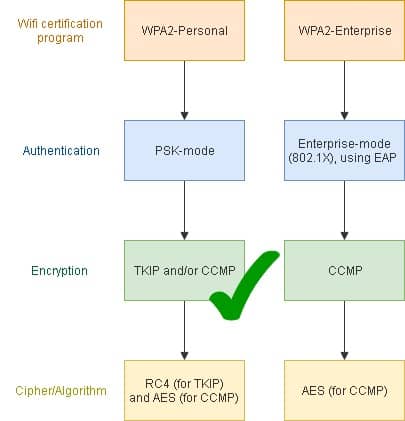

#Wep vs wpa no end to end encryption free#
However, a word of warning: free VPN services are possibly making their money from your data, which may be a concern for some. They’re a great way to make sure your internet traffic is secure and hidden from prying eyes, even when you can’t be completely assured that the Wi-Fi network you’re using is as secure as it could be. This is fine if you have a company whose VPN you can use, but if not there are plenty of free and paid-for VPN services available. Nobody can see what’s happening within that tunnel and the data sent through it is encrypted, too. In order to secure that connection she can connect to her company’s VPN, effectively creating a secure tunnel between her computer and those of her company. An example here would be a user in an airport who needs to do some work but doesn’t trust the network she is connected to. What is a Virtual Private Network (VPN)?Ī VPN or Virtual Private Network allows users to connect their device to the internet via a secure, encrypted tunnel. However, no matter how good the security of the Wi-Fi connection happens to be, there are still things that can go wrong, and for that we have VPNs.

This is currently the safest option available to those setting up Wi-Fi networks and should be deemed a minimum requirement by most. To date there is one primary security vulnerability relating to the standard, although attackers would need direct access to the access point in order to take advantage of it. The answer to all of this was WPA2, a replacement for WPA that arrived in 2006. However, the fact that there was a level of backward compatibility meant that some WEP frailties were carried over to WPA and, as a result, it too was heavily compromised. That means that the data transmitted over the airwaves is substantially more “scrambled,” making it almost impossible to break into. The keys used by WPA are 256-bit, a huge improvement over the 64-bit and 128-bit keys used in the WEP system. A standard WPA configuration makes use of WPA-PSK, or Pre-Shared Key. The level of security offered by WEP was always debatable, and after numerous flaws were discovered, the Wi-Fi Alliance officially retired WEP in 2004.įollowing its arrival in 2003, WPA was thought to be the answer to the WEP problem. Wired Equivalent Privacy, or WEP, was at one point the most widely used Wi-Fi security protocol. If you trust the Wi-Fi connection and have these measures in place, that’s a decision only you can make.
#Wep vs wpa no end to end encryption install#
These normally require you to install a profile on your device, or complete a registration and login process once connected. There are some Wi-Fi connections that you receive as part of your home Internet package, or perhaps via your cellular provider. That’s pretty self-explanatory, and you probably shouldn’t connect to any network like this, although there are caveats. If you can at least connect to public Wi-Fi without initially entering a password, it’s wide open. There are a few different security levels you are likely to encounter when connecting to public Wi-Fi: When you connect to any Wi-Fi network, at home or in public, you need to be aware of the level of security that’s in use. The chances of your data being intercepted on public Wi-Fi may be relatively low, but it can and does happen. 5 tips for staying safe on public Wi-Fi.How 1Password keeps your passwords safe on public Wi-Fi.

What is a Virtual Private Network (VPN)?.

Here’s what you need to know to work safely on the move. Working on the go has become the norm, and while public Wi-Fi is everywhere, it isn’t always secure - but luckily, it isn’t too difficult to protect yourself.


 0 kommentar(er)
0 kommentar(er)
